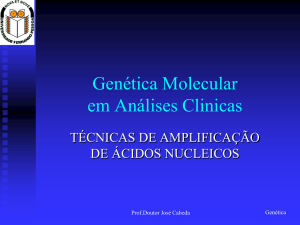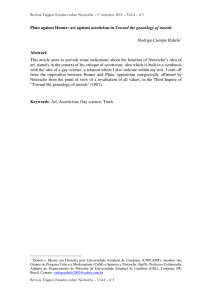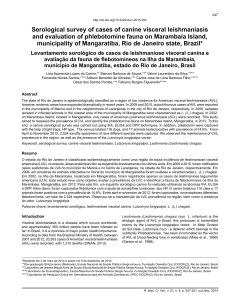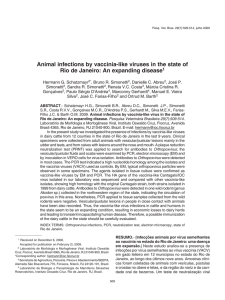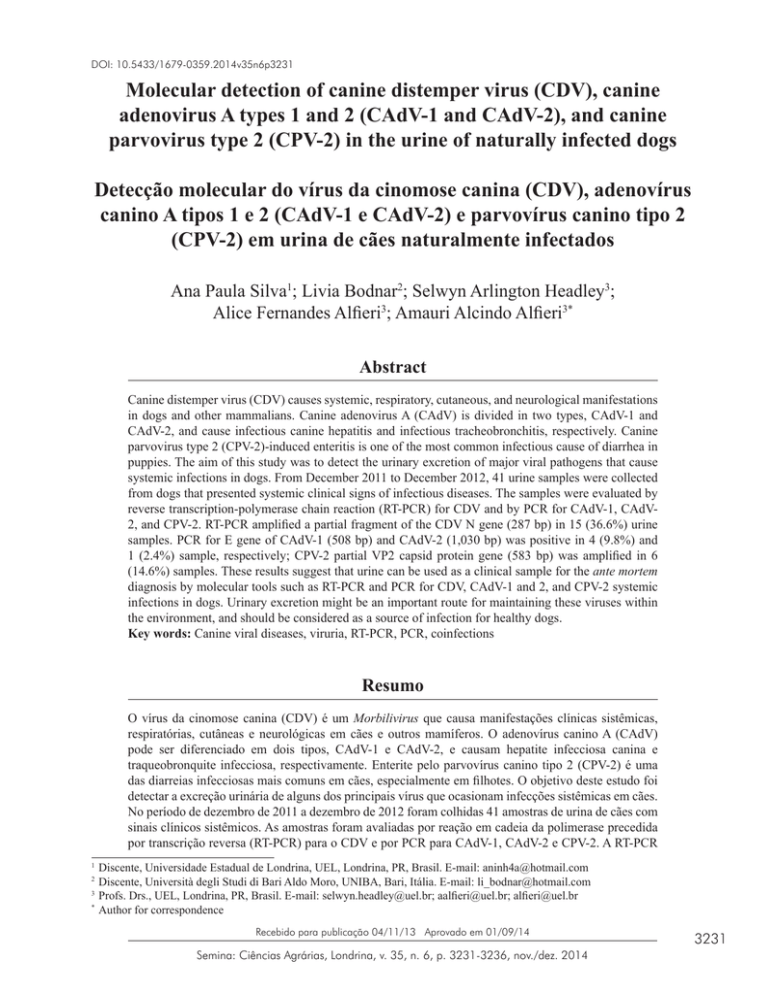
DOI: 10.5433/1679-0359.2014v35n6p3231
Molecular detection of canine distemper virus (CDV), canine
adenovirus A types 1 and 2 (CAdV-1 and CAdV-2), and canine
parvovirus type 2 (CPV-2) in the urine of naturally infected dogs
Detecção molecular do vírus da cinomose canina (CDV), adenovírus
canino A tipos 1 e 2 (CAdV-1 e CAdV-2) e parvovírus canino tipo 2
(CPV-2) em urina de cães naturalmente infectados
Ana Paula Silva1; Livia Bodnar2; Selwyn Arlington Headley3;
Alice Fernandes Alfieri3; Amauri Alcindo Alfieri3*
Abstract
Canine distemper virus (CDV) causes systemic, respiratory, cutaneous, and neurological manifestations
in dogs and other mammalians. Canine adenovirus A (CAdV) is divided in two types, CAdV-1 and
CAdV-2, and cause infectious canine hepatitis and infectious tracheobronchitis, respectively. Canine
parvovirus type 2 (CPV-2)-induced enteritis is one of the most common infectious cause of diarrhea in
puppies. The aim of this study was to detect the urinary excretion of major viral pathogens that cause
systemic infections in dogs. From December 2011 to December 2012, 41 urine samples were collected
from dogs that presented systemic clinical signs of infectious diseases. The samples were evaluated by
reverse transcription-polymerase chain reaction (RT-PCR) for CDV and by PCR for CAdV-1, CAdV2, and CPV-2. RT-PCR amplified a partial fragment of the CDV N gene (287 bp) in 15 (36.6%) urine
samples. PCR for E gene of CAdV-1 (508 bp) and CAdV-2 (1,030 bp) was positive in 4 (9.8%) and
1 (2.4%) sample, respectively; CPV-2 partial VP2 capsid protein gene (583 bp) was amplified in 6
(14.6%) samples. These results suggest that urine can be used as a clinical sample for the ante mortem
diagnosis by molecular tools such as RT-PCR and PCR for CDV, CAdV-1 and 2, and CPV-2 systemic
infections in dogs. Urinary excretion might be an important route for maintaining these viruses within
the environment, and should be considered as a source of infection for healthy dogs.
Key words: Canine viral diseases, viruria, RT-PCR, PCR, coinfections
Resumo
O vírus da cinomose canina (CDV) é um Morbilivirus que causa manifestações clínicas sistêmicas,
respiratórias, cutâneas e neurológicas em cães e outros mamíferos. O adenovírus canino A (CAdV)
pode ser diferenciado em dois tipos, CAdV-1 e CAdV-2, e causam hepatite infecciosa canina e
traqueobronquite infecciosa, respectivamente. Enterite pelo parvovírus canino tipo 2 (CPV-2) é uma
das diarreias infecciosas mais comuns em cães, especialmente em filhotes. O objetivo deste estudo foi
detectar a excreção urinária de alguns dos principais vírus que ocasionam infecções sistêmicas em cães.
No período de dezembro de 2011 a dezembro de 2012 foram colhidas 41 amostras de urina de cães com
sinais clínicos sistêmicos. As amostras foram avaliadas por reação em cadeia da polimerase precedida
por transcrição reversa (RT-PCR) para o CDV e por PCR para CAdV-1, CAdV-2 e CPV-2. A RT-PCR
Discente, Universidade Estadual de Londrina, UEL, Londrina, PR, Brasil. E-mail: [email protected]
Discente, Università degli Studi di Bari Aldo Moro, UNIBA, Bari, Itália. E-mail: [email protected]
3
Profs. Drs., UEL, Londrina, PR, Brasil. E-mail: [email protected]; [email protected]; [email protected]
*
Author for correspondence
1
2
Recebido para publicação 04/11/13 Aprovado em 01/09/14
Semina: Ciências Agrárias, Londrina, v. 35, n. 6, p. 3231-3236, nov./dez. 2014
3231
Silva, A. P. et al.
amplificou um fragmento do gene N do CDV (287 pb) em 15 (36,6%) amostras. A PCR para o gene E do
CAdV-1 (508 pb) e do CAdV-2 (1030 pb) foi positiva em 4 (9,8%) e 1 (2,4%) amostra, respectivamente;
o gene VP2 da proteína do capsídeo do CPV-2 (583 pb) foi amplificado em 6 (14,6%) amostras. Estes
resultados sugerem que a urina pode ser utilizada como amostra clínica para o diagnóstico ante mortem
de infecções sistêmicas por CDV, CAdV-1 e 2 e CPV-2 por técnicas moleculares como RT-PCR e PCR.
Adicionalmente, a excreção viral pela urina parece ser uma importante rota para a manutenção destes
vírus no ambiente e deve ser considerada como fonte de infecção para cães saudáveis.
Palavras-chave: Doenças virais caninas, virúria, RT-PCR, PCR, coinfecções
Canine distemper virus (CDV) is a Morbilivirus
that causes systemic, respiratory, cutaneous, and
neurological manifestations in dogs and other
mammalians (GREENE; VANDEVELDE, 2012).
CDV is considered as one of the major causes
of mortality of young and adult dogs in Brazil,
impacting the local economy due to the therapy
associated with the systemic effects of CDV
(HEADLEY et al., 2012). Canine adenovirus A
(CAdV) is differentiated in two types, CAdV-1 and
CAdV-2, which are closely related genetically and
antigenically. CAdV-1 and CAdV-2 are responsible
for infectious canine hepatitis, characterized by
corneal edema, and infectious tracheobronchitis,
respectively
(DECARO;
MARTELLA;
BUONAVOGLIA, 2008). Canine parvovirus
enteritis is one of the most common infectious
diarrheic disease of dogs, and is caused by distinct
strains of canine parvovirus 2 (CPV-2, 2a, 2b, and
2c). The clinical illness of CPV-2 is more common
in young pups that are not vaccinated, especially
between 6 weeks and 6 months of age (GREENE;
DECARO, 2012).
The clinical diagnosis of canine distemper,
infectious
canine
hepatitis,
infectious
tracheobronchitis and canine parvovirus enteritis
are often difficult due to the variability of clinical
manifestations. The use of RT-PCR and PCR asseys
to detect CDV RNA, and CAdV-1 and CAdV-2
DNA in the urine of dogs with clinical signs of these
diseases has been reported (NEGRÃO; ALFIERI;
ALFIERI, 2007; HEADLEY et al., 2013). Urine is
easier to collect than other body fluids and is useful
in the ante mortem diagnosis of distemper and other
viral diseases (SAITO et al., 2006; HEADLEY et
al., 2013). The current study evaluated the use of
urine in RT-PCR and PCR assays for the detection
of CDV, CAdV-1, CAdV-2, and CPV-2.
From December 2011 to December 2012, 41
urine samples from dogs were received at the
Laboratory of Animal Virology, Universidade
Estadual de Londrina, southern Brazil, to be
evaluated for the presence of CDV. However,
there is known associated description of clinical
manifestations, immunological status, vaccination
schedule, age, gender, or history of the animals.
All samples were collected via cystocentesis or
urethral catheterization. In addition to distemper,
the samples were also evaluated by PCR assays for
the detection of CAdV-1, CAdV-2, and CPV-2.
Nucleic acid were extracted from a volume of
300 µL of the urine sample by using the silica/
guanidine isothiocyanate method (BOOM et al.,
1990). Positive controls consisted of aliquots from
commercial vaccines (CAdV-2 and CPV-2), and
from previously described cases (CAdV-1 and
CDV) (HEADLEY et al., 2013); nuclease-free
water (Invitrogen™ Life Technology) was used as
negative control.
The RT-PCR assay targeted a 287 base pair
(bp) fragment of the N gene of CDV (FRISK et al.,
1999), with modifications (SAITO et al., 2006). The
amplification of CAdV-1 and CAdV-2 viral DNA
was performed by using a PCR assay designed to
detect the 508 bp and 1,030 bp fragments of the E
gene of CAdV-1 and CAdV-2, respectively (HU
et al., 2001). PCR assay was also performed to
amplify the 583 bp fragment of the VP2 gene of
CPV-2 (HONG et al., 2007). The PCR products
3232
Semina: Ciências Agrárias, Londrina, v. 35, n. 6, p. 3231-3236, nov./dez. 2014
Molecular detection of canine distemper virus (CDV), canine adenovirus A type 1 and 2 (CAdV-1 and CAdV-2), and canine ...
were analyzed by electrophoresis in 2% agarose gels
stained with ethidium bromide, and visualized under
UV light. The primers used in the RT-PCR and PCR
assays are given in Table 1. The partial nucleotide
sequences of the CDV N gene, CAdV-1 E gene, and
CPV-2 VP2 gene obtained were initially compared
with those deposited in GenBank by using BLAST
(http://www.ncbi.nlm.nih.gov/BLAST).
Table 1. Primers used for the detection of viruria in dogs with systemic infections.
Virus
Primer
p1 (F)
p2 (R)
HA1 (F)
CAdV-1 and
CAdV-2
HA2 (R)
Forward (F)
CPV-2
Reverse (R)
CDV
Sequence (5’-3’)
ACAGGATTGCTGAGGACCTAT
CAAGATAACCATGTACGGTGC
CGCGCTGAACATTACTACCTTGTC
CCTAGAGCACTTCGTGTCCGCTT
CAGGAAGATATCCAGAAGGA
GGTGCTAGTTGATATGTAATAAACA
Target gene
Amplicon
size (bp)
Nucleoprotein
287
E3
508 and
1,030
VP2
583
References
Frisk et al.,
1999
Hu et al.,
2001
Hong et al.,
2007
F (forward); R (reverse).
Source: Elaborated by the authors.
The results of the demonstration of viruria
are shown in Table 2. Of the 41 urine samples
analyzed, 21 (51.2%) contained at least one of
the viruses evaluated in this study. The RT-PCR
assay for CDV N gene amplified the expected
287 bp fragment in 15 (36.6%) samples. CAdV1 and CAdV-2 DNA were identified in 4 (9.8%)
and 1 (2.4%) of the evaluated urine samples,
respectively. CPV-2 was detected by PCR assay
in 6 (14.6%) urine samples. Twenty (48.8%)
samples were negative for all viruses evaluated.
Of the 21 positive samples, viruria due to a single
viral pathogen was observed in 18 (85.7%) of
these. Concomitant detection of viral pathogens
occurred in 3 (14.3%) urine samples. One of
these demonstrated viruria for all four agents
evaluated (CDV, CAdV-1, CAdV-2, and CPV-2);
one sample was positive for CDV and CAdV-1,
while concomitant CDV and CPV-2 viruria was
observed in another sample.
Table 2. Molecular (RT-PCR or PCR) detection of viruria from 41 urine samples of dogs.
Virus
Single
12
2
--4
CDV
CAdV-1
CAdV-2
CPV-2
Infections
Mixed
3
2
1
2
TOTAL
15
4
1
6
Source: Elaborated by the authors.
Coinfections of CDV with other infectious
microorganisms have been reported (DAMIÁN
et al., 2006; SAITO et al., 2006; CHVALA et al.,
2007, HEADLEY et al., 2013), suggesting that the
immunosuppressive effects of CDV may facilitate
the maintenance of other pathogens (DAMIÁN et
3233
Semina: Ciências Agrárias, Londrina, v. 35, n. 6, p. 3231-3236, nov./dez. 2014
Silva, A. P. et al.
al., 2006; CHVALA et. al., 2007; HEADLEY et
al., 2013). Saito et al. (2006) described 22 cases
of dogs that had clinical signs of canine distemper
associated with viruria. According to Negrão, Alfieri
and Alfieri (2007), more than one type of clinical
sample should be evaluated for CDV considering
the different clinical manifestations of canine
distemper. Therefore, urine should be included as
biological material for the ante mortem diagnosis
of CDV by RT-PCR since it is easier to collect
than cerebrospinal fluid (CSF) and as sensitive as
leucocytes, biological samples normally used for
diagnosis of CDV.
for healthy dogs. The reduced detection of CAdV1, CAdV-2, and CPV-2 viruria in this study may
be due to the lack of medical history and physical
examination of the dogs, and to a sampling bias,
since the urine samples were sent for the laboratorial
diagnosis of canine distemper. It would be worthy
to investigate if the CDV, CAdV-1, CAdV-2, and
CPV-2 associated viruria has any relationship on
the stage of infection and clinical signs presented
by the affected dog, and for how long these viruses
are excreted via the urinary system after the infected
animal has clinically recovered.
Urine excretion occurs in CAdV-1 infection as
the virus disseminate to several tissues and body
secretions after viremia. CAdV-1 persists in the
renal tubular epithelium for 14 days after infection
(GREENE, 2012), suggesting viruria. Headley et
al. (2013) have described the detection of CAdV-2
DNA in urine by PCR, also suggesting excretion via
urinary system.
References
CPV-2 produces lesions predominantly within
the gastrointestinal tract (GREENE, DECARO,
2012). After viremia, the virus can be detected in
lymphoid tissues, lungs, spleen, liver, myocardium,
and kidneys (GREENE, DECARO, 2012). However,
the excretion of CPV-2 via the urinary system has
not been previously described as far as the authors
of this study are aware.
PCR and RT-PCR are helpful diagnostic tools
due to their elevated specificity and sensitivity and
quick results, assisting the clinician to establish the
best possible treatment for the patient. As it has been
previously described in CDV studies, urine is a more
sensitive sample than serum and leucocytes in RTPCR assays, and easier to collect than CSF, making
urine a good biological sample for the ante mortem
diagnosis of CDV (SAITO et al., 2006; NEGRÃO;
ALFIERI; ALFIERI, 2007). These findings suggest
that urine excretion might be an important route
for maintaining these viruses in the environment,
and should be considered as a source of infection
BOOM, R.; SOL, C. J.; SALIMANS, M. M.; JANSEN,
C. L.; WERTHEIM-VAN DILLEN, P. M.; VAN DER
NOORDAA, J. Rapid and simple method for purification
of nucleic acids. Journal of Clinical Microbiology,
Washington, v. 28, n. 3, p. 495-503, 1990.
CHVALA, S.; BENETKA, V.; MÖSTL, K;
ZEUGSWETTER, F.; SPERGSER J.; WEISSENBÖCK,
H. Simultaneous canine distemper virus, canine
adenovirus type 2, and Mycoplasma cynos infection in a
dog with pneumonia. Veterinary Pathology, Washington,
v. 44, n. 4, p. 508-512, 2007.
DAMIÁN, M.; MORALES, E.; SALAS, G.; TRIGO,
F. J. Immunohistochemical detection of antigens of
distemper, adenovirus, and parainfluenza viruses in
domestic dogs with pneumonia. Journal of Comparative
Pathology, Edinburgh, v. 133, n. 4, p. 289-293, 2006.
DECARO, N.; MARTELLA, V.; BUONAVOGLIA, C.
Canine adenoviruses and herpesvirus. Veterinary Clinics
SmallAnimal Practice, St. Louis, v. 38, n. 4, p. 799-814,
2008.
FRISK, A. L.; KONIG, M.; MORITZ, A.;
BAUMGARTNER, W. Detection of canine distemper
virus nucleoprotein RNA by reverse transcription-PCR
using serum, whole blood, and cerebrospinal fluid from
dogs with distemper. Journal of Clinical Microbiology,
Washington, v. 37, n. 11, p. 3634-3643, 1999.
GREENE, C. E. Infectious Canine Hepatitis and Canine
acidophil cell hepatitis. In: ______. Infectious diseases
of the dog and cat. 4th ed. St. Louis: Elsevier, 2012. p.
42-48.
GREENE, C. E.; DECARO, N. Canine viral enteritis. In:
GREENE, C. E. Infectious diseases of the dog and cat. 4th
ed. St. Louis: Elsevier, 2012. p. 67-80.
3234
Semina: Ciências Agrárias, Londrina, v. 35, n. 6, p. 3231-3236, nov./dez. 2014
Molecular detection of canine distemper virus (CDV), canine adenovirus A type 1 and 2 (CAdV-1 and CAdV-2), and canine ...
GREENE, C. E.; VANDEVELDE, M. Canine distemper.
In: GREENE, C. E. Infectious diseases of the dog and
cat. 4th ed. St. Louis: Elsevier, 2012. p. 25-42.
HEADLEY, S. A.; AMUDE, A. M.; ALFIERI, A.
F.; BRACARENSE, A. P. F. R. L.; ALFIERI, A. A.
Epidemiological features and the neuropathological
manifestations of canine distemper virus induced
infections in Brazil: a review. Semina: Ciências Agrárias,
Londrina, v. 33, n. 5, p. 1945-1978, 2012.
HEADLEY, S. A.; ALFIERI, A. A.; FRITZEN, J. T.
T.; GARCIA, J. L.; WEISSENBÖCK, H.; SILVA,
A. P.; BODNAR, L.; OKANO, W.; ALFIERI, A. F.
Concomitant canine distemper, infectious canine
hepatitis, canine parvoviral enteritis, canine infectious
tracheobronchitis, and toxoplasmosis in a puppy. Journal
of Veterinary Diagnostic Investigation, Columbia, v. 25,
n. 1, p. 129-135, 2013.
HONG, C.; DECARO, N.; DESARIO, C.; TANNER, P.;
PARDO, M. C.; SANCHEZ, S.; BUONAVOGLIA, C.;
SALIKI, J. T. Occurrence of canine parvovirus type 2c
in the United States. Journal of Veterinary Diagnostic
Investigation, Columbia, v. 19, n. 5, p. 535-539, 2007.
HU, R. L.; HUANG, G.; QIU, W.; ZHONG, Z. H.; XIA,
X. Z.; YIN, Z. Detection and differentiation of CAV-1
and CAV-2 by polymerase chain reaction. Veterinary
Research Communications, Amsterdam, v. 25, p. 77-84,
2001.
NEGRÃO, F. J.; ALFIERI, A. A.; ALFIERI, A. F.
Avaliação de urina e leucócitos como amostras biológicas
para a detecção ante mortem do vírus da cinomose canina
por RT-PCR em cães naturalmente infectados. Arquivo
Brasileiro de Medicina Veterinária e Zootecnia, Belo
Horizonte, v. 59, n. 1, p. 253-257, 2007.
SAITO, T. B.; ALFIERI, A. A.; WOSIACKI, S. R.;
NEGRÃO, F. J.; MORAIS, H. S. A.; ALFIERI, A.
F. Detection of canine distemper virus by reverse
transcriptase-polymerase chain reaction in the urine
of dogs with clinical signs of distemper encephalitis.
Research in Veterinary Science, London, v. 80, n. 1, p.
116-119, 2006.
3235
Semina: Ciências Agrárias, Londrina, v. 35, n. 6, p. 3231-3236, nov./dez. 2014
Silva, A. P. et al.
3236
Semina: Ciências Agrárias, Londrina, v. 35, n. 6, p. 3231-3236, nov./dez. 2014

